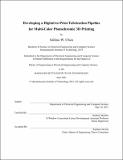Developing a Digital-to-Print Fabrication Pipeline for Multi-Color Photochromic 3D Printing
Author(s)
Chen, Sabina W.
DownloadThesis PDF (84.86Mb)
Advisor
Mueller, Stefanie
Terms of use
Metadata
Show full item recordAbstract
Stereolithography (SLA) and digital light processing (DLP) 3D printing are two common resin-based 3D printing processes. These printing processes work by projecting a light source onto specific areas of resin, thereby forming thin layers of plastic that eventually stack up to create solid objects. However, one limitation of SLA and DLP resin printing is that they typically only produce single-color prints because only one resin type can be used at a time. Therefore, we present a novel approach that enables multi-color resin printing using photochromic dyes. By combining DLP with photochromic materials, our end-to-end 3D printing fabrication pipeline can create multi-colored objects using only one type of resin-based material.
Instead of using a standard, single-color resin, our resin contains a mixture of photochromic inks that can change color when exposed to different wavelengths of light. By integrating photochromic materials into a UV curable resin, we can programmatically change the color of the resin depending on the type of RGB light projected. To build our 3D printing system, we modified an existing resin-based 3D printer to incorporate both a UV and visible light projection system. This enables us to control both the curing and coloring of an object separately. By saturating the dyes prior to printing, and then projecting combinations of RGB light onto each layer after it has been cured, we can color objects directly during the printing process.
In this thesis, we provide the implementation details and design decisions that went into building this integrated 3D printing infrastructure. We discuss the user interface, printer hardware, software implementation, and photochromic resin formulation. We also provide operational instructions and explanations for key design decisions of our system. Finally, we evaluate the capabilities of our photochromic resin and printer system, and propose topics for future work.
Date issued
2021-06Department
Massachusetts Institute of Technology. Department of Electrical Engineering and Computer SciencePublisher
Massachusetts Institute of Technology